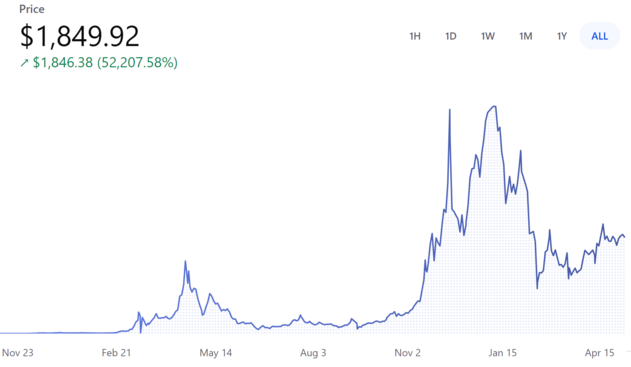Ethereum: Difference between revisions
No edit summary |
No edit summary |
||
| Line 9: | Line 9: | ||
|'''Founder''' | |'''Founder''' | ||
|Vitalik Buterin | |Vitalik Buterin | ||
|- | |||
|'''Native cryptocurrency''' | |||
|Ether (ETH) | |||
|- | |||
|'''Consensus''' | |||
|Proof of stake (PoS) | |||
|- | |- | ||
|'''Website''' | |'''Website''' | ||
|[https://ethereum.org ethereum.org] | |[https://ethereum.org ethereum.org] | ||
|} | |} | ||
]] | ]] | ||
| Line 23: | Line 26: | ||
* The Ethereum network acts as the foundation for communities, applications, organisations and digital assets that is accessible for creation and utilization by anyone<ref name=":0" />. | * The Ethereum network acts as the foundation for communities, applications, organisations and digital assets that is accessible for creation and utilization by anyone<ref name=":0" />. | ||
* Ethereum is renowned primarily for its native cryptocurrency, Ether (ETH)<ref>https://www.investopedia.com/terms/e/ethereum.asp</ref>. | * Ethereum is renowned primarily for its native cryptocurrency, Ether (ETH)<ref>https://www.investopedia.com/terms/e/ethereum.asp</ref>. | ||
=== What can Ethereum do<ref name=":0" />? === | |||
* Banking: Ethereum offers an inclusive platform accessible to everyone, and it provides financial services such as lending, borrowing and savings products. | |||
* An open internet: Users have full control over their own assets and identity, instead of them being controlled by a few mega-corporations. | |||
* A peer-to-peer (p2p) network: Ethereum allows users to coordinate, make agreements or transfer digital assets directly with each other, eliminating the need for intermediaries. | |||
* Censorship-resistant: No government or company has control over Ethereum. The decentralized nature of Ethereum makes it nearly impossible for anyone to ban its services. | |||
* Commerce guarantees: Users benefit from a secure, built-in guarantee on Ethereum, assuring that funds will only change hands when agreed-upon conditions are met. | |||
* Composable products: All applications are built on the same blockchain with a shared global state, meaning they can build off each other. This ensures that no one can remove essential tools or components relied upon, providing greater stability, trust, and user experience within the network. | |||
=== How does Ethereum work? === | === How does Ethereum work? === | ||
| Line 75: | Line 86: | ||
|Records stored on a blockchain and can be viewed publicly | |Records stored on a blockchain and can be viewed publicly | ||
|} | |} | ||
Smart contracts | Smart contracts serve as the cornerstone of Ethereum applications. They have the capability to perform nearly anything that other computer programs can do with the above benefits. They can perform computations, create currency, store data, mint NFTs, send communications, generate graphics, etc. | ||
* '''ETH''' | * '''ETH''' | ||
Every independent blockchain has its own native cryptocurrency that is used to reward miners and validators adding blocks to the blockchain and as a payment method, including for transaction fees<ref>https://www.investopedia.com/what-are-native-tokens-6754173</ref>. In Ethereum's case, its native cryptocurrency is called Ether (ETH), which can be used to pay for executing smart contracts on the Ethereum platform. The price of ETH | Every independent blockchain has its own native cryptocurrency that is used to reward miners and validators adding blocks to the blockchain and as a payment method, including for transaction fees (gas fees)<ref>https://www.investopedia.com/what-are-native-tokens-6754173</ref>. In Ethereum's case, its native cryptocurrency is called Ether (ETH), which can be used to pay for executing smart contracts on the Ethereum platform. The price of ETH symbolizes the value of the Ethereum ecosystem, as Ethereum is not a company with stock. Therefore, the primary method of investing in Ethereum is by purchasing ETH. | ||
=== NFT === | === NFT === | ||
Revision as of 10:50, 27 July 2023

| Type | Decentralized blockchain |
| Release date | 30 July 2015 |
| Founder | Vitalik Buterin |
| Native cryptocurrency | Ether (ETH) |
| Consensus | Proof of stake (PoS) |
| Website | ethereum.org |
What is Ethereum?
- Ethereum is a globally distributed network of computers that is powered by blockchain technology[1].
- The Ethereum network acts as the foundation for communities, applications, organisations and digital assets that is accessible for creation and utilization by anyone[1].
- Ethereum is renowned primarily for its native cryptocurrency, Ether (ETH)[2].
What can Ethereum do[1]?
- Banking: Ethereum offers an inclusive platform accessible to everyone, and it provides financial services such as lending, borrowing and savings products.
- An open internet: Users have full control over their own assets and identity, instead of them being controlled by a few mega-corporations.
- A peer-to-peer (p2p) network: Ethereum allows users to coordinate, make agreements or transfer digital assets directly with each other, eliminating the need for intermediaries.
- Censorship-resistant: No government or company has control over Ethereum. The decentralized nature of Ethereum makes it nearly impossible for anyone to ban its services.
- Commerce guarantees: Users benefit from a secure, built-in guarantee on Ethereum, assuring that funds will only change hands when agreed-upon conditions are met.
- Composable products: All applications are built on the same blockchain with a shared global state, meaning they can build off each other. This ensures that no one can remove essential tools or components relied upon, providing greater stability, trust, and user experience within the network.
How does Ethereum work?
In brief, Ethereum = Blockchain + Smart contracts + ETH.
- Blockchain[3]
Blockchain is simply a database of specific data that continuously grows, with the following characteristics:
- Once data is stored in the database, it can never be modified or deleted. Each record on the blockchain is permanently preserved.
- No individual or organization can maintain the database alone. It requires an agreement of the majority of users within the database, with each user holding a copy of the database.
Imagine a network of 10 individuals. Each person has an empty folder and a blank page. Whenever any person performs an action, such as a transaction, a notification is sent to everyone in the network. Each person then records the notification on their own page. When the page is completely filled, each individual must seal the page's content and ensure that all pages in the network are identical. Once sealed, the content in the page can never be altered and the page is added to the folder.
Over time, these pages (blocks) containing content (transactions) will be sequentially added to the folders (chain), thus forming a database (blockchain).
- Smart contracts[4]
Smart contracts are computer programs stored on the Ethereum blockchain that allow converting conventional contracts into digital parallels. Smart contracts follows an "if this then that" structure, which means they behave exactly as programmed and cannot be altered. Contracts are essentially agreements. People make agreements verbally or write pen-and-paper contracts and fullfill the agreements after certain conditions are reached. However, these conventional contracts are not without their flaws. Enter smart contracts, the perfect solution to address these shortcomings.
| Conventional contracts | Smart contracts | |
|---|---|---|
| Execution | Executed by human through the court system | Automatically executed |
| Validity | Valid only if both parties agree and sign | Can be vlidated by anyone on the Ethereum networks |
| Security | Less secure as they are stored in paper form or digitally | Highly secure as they are stored on a blockchain |
| Modification | Easily modified with mutual consent of both parties | Difficult to modify |
| Cost | Require the use of third-party intermediaries, making them more expensive | Cost-effective due to the removal of third-party intermediaries |
| Accuracy | Prone to errors due to human involvement | Accurate due to the use of code |
| Record Keeping | Records stored in paper form or digitally, not publicly available | Records stored on a blockchain and can be viewed publicly |
Smart contracts serve as the cornerstone of Ethereum applications. They have the capability to perform nearly anything that other computer programs can do with the above benefits. They can perform computations, create currency, store data, mint NFTs, send communications, generate graphics, etc.
- ETH
Every independent blockchain has its own native cryptocurrency that is used to reward miners and validators adding blocks to the blockchain and as a payment method, including for transaction fees (gas fees)[6]. In Ethereum's case, its native cryptocurrency is called Ether (ETH), which can be used to pay for executing smart contracts on the Ethereum platform. The price of ETH symbolizes the value of the Ethereum ecosystem, as Ethereum is not a company with stock. Therefore, the primary method of investing in Ethereum is by purchasing ETH.
NFT
Ethereum vs. Bitcoin
| Ethereum[7] | Bitcoin[8] | |
|---|---|---|
| Popularity | #2 | #1 |
| Type | Decentralized blockchain | Digital currency |
| Circulating supply | 120.2M ETH | 19.4M BTC |
| Total supply | Infinite | 21M BTC |
| Market cap | $222.4B | $568.1B |
| All time high | $4,891.70 | $68,789.63 |
- Since Bitcoin stands as the pioneering and most renowned cryptocurrency, drawing a comparison between Bitcoin and Ethereum proves highly beneficial when analyzing Ethereum. As Bitcoin's primary competitor, Ethereum is ranked #2 on most cryptocurrency platforms, while Bitcoin is ranked #1.
- While this section focuses on comparing Ethereum and Bitcoin, it's essential to acknowledge that they are not of the same kind. Ethereum operates as a decentralized blockchain, where cryptocurrency is merely one of its numerous applications (financial services, games, social networks, etc.). In contrast, Bitcoin exclusively functions as a cryptocurrency, akin to the virtual counterpart of a dollar.
- The circulating supply of a cryptocurrency represents the number of tokens that have been issued and are actively available in the market. For Bitcoin, over 90% of its total supply has already been mined. On the other hand, Ethereum does not have a finite supply.
- While the concept of unlimited supply may raise concerns for Ethereum, it actually contributes to its stability as a cryptocurrency and sets it apart from becoming the next Bitcoin. This characteristic prevents scarcity-driven market behaviors and allows for a more sustainable and adaptable ecosystem for Ethereum, ensuring its continued relevance and functionality.
- Market cap is calculated by multiplying the asset's current price and its circulating supply.
- Buterin dreamed up Ethereum as a way to leverage the blockchain technology underlying Bitcoin for all sorts of uses beyond currency[9].
Valuation
Risks
- Regulatory
- Technological
- Collapsing of Bitcoin
References and notes
- ↑ 1.0 1.1 1.2 https://ethereum.org/en/what-is-ethereum/
- ↑ https://www.investopedia.com/terms/e/ethereum.asp
- ↑ https://online.stanford.edu/how-does-blockchain-work
- ↑ https://ethereum.org/en/smart-contracts/
- ↑ https://www.geeksforgeeks.org/smart-contracts-vs-traditional-contracts/
- ↑ https://www.investopedia.com/what-are-native-tokens-6754173
- ↑ https://www.coinbase.com/price/ethereum
- ↑ https://www.coinbase.com/price/bitcoin
- ↑ https://time.com/6158182/vitalik-buterin-ethereum-profile/
